
| 
|


Friends Newsletter No. 69
January 2016
Friends are the recognised guardians of Malvern's water heritage (Malvern Gazette 1 March 2013 p.14). We are an independent voluntary group who relentlessly promote research, conservation and celebration of the Springs, Spouts, Fountains and Holy Wells of the Malvern Hills and of Great Malvern as a Spa Town.
Springs and Wells Stamp
We recently came across a mint 1st class stamp with, would you believe, a well on it and a sixpence. With a little research we discovered it was one of a set of 10 issued in 1991. The design was created by Tony Meeuwissen. Tony has designed more than stamps. Born in 1938, Tony has been quietly beavering away since the mid-1950s. Over the decades, he has been responsible for some of the most staggeringly beautiful work ever produced: work that has constantly won awards, accolades and praise along the way. His skills have extended to books and playing cards amongst other things. He has won the Victoria & Albert Museum's illustration award and uniquely scooped two gold and two silver awards from The Designers and Art Directors Association (D&AD). A collection of his work resides in the V&A's Department of Prints and Drawings. This stamp is a must have item for springs and wells enthusiasts and so we are deciding who we should post it to and what to enclose with it to make it a memorable treasure.
Recent Discovery - a Friend responds
In the previous newsletter we revealed a picture that we had discovered of the original fountain at St Ann's Well. There was some confusion with the 1823 accreditation of the picture because dates did not match the historic record. A Friend has kindly responded as follows:
"Although the book was first published in 1823, this is unlikely to be an illustration from that edition, but from a reprint, judging by the ladies' fashions. The name at the foot of the picture is 'Cuthbert Bede', which the internet says is a pseudonym of Edward Bradley. He was born in Kidderminster, in 1827, and married a lady from Wolverley in 1858, when he was a clergyman at Bobbington. Clearly this picture is from an edition much later than the first; some time before the bustle replaced the crinoline."
St Werstan Awards
The ballot to see if the New Myrtles Fountain would qualify for a St Werstan Award (see Newsletter 68), indicated that the scores were low on several factors. We propose reviewing matters again in the not too distant future when time will likely have resolved the problem issues.

David Habershon
With great regret we report the death in October 2015 of David Habershon. He was a great Friend and former chairman of High Street Malvern. He will be remembered for saving the historic Tudor House Hotel, Great Malvern after many years of decay and a damaging fire. His company converted the premises into desirable apartments,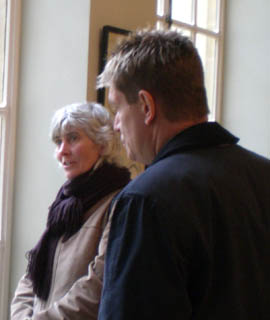 thereby avoiding demolition and giving the building a new lease of life. For this he won the coveted Malvern Civic Society Award in 2013.
thereby avoiding demolition and giving the building a new lease of life. For this he won the coveted Malvern Civic Society Award in 2013.
 thereby avoiding demolition and giving the building a new lease of life. For this he won the coveted Malvern Civic Society Award in 2013.
thereby avoiding demolition and giving the building a new lease of life. For this he won the coveted Malvern Civic Society Award in 2013.Malvern has lost a local entrepreneur who bravely set out to resolve the long term devastation and decay of a Malvern architectural and historic treasure.
In the picture above: the Tudor House Hotel under reconstruction Christmas 2011. Picture right: David in Bath with Cora researching new spa developments at the famous hot springs.
Malvern's Civic Week's (2016) opening ceremony will include planting a Mulberry Tree and unveiling a plaque in Priory Park near the Priory Park Spring (site number 106). The date set is Saturday 25 June with the unveiling late morning.
Click the tree left for more details.
Tank House: latest update
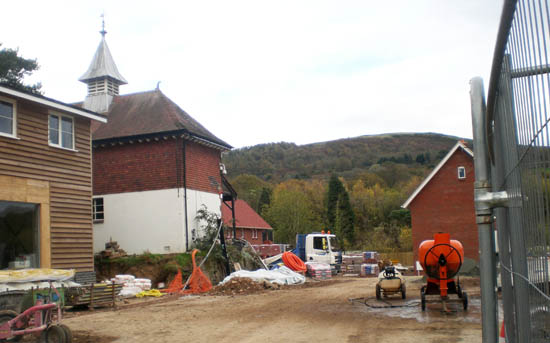
The closure of the Schweppes Bottling Plant at Colwall caused much concern. Now the site is almost unrecognisable with the major developments going on there. The replica building of the Holy Well called the Tank House is surrounded by the planned residential and retail buildings yet still retains a clear line of visibility to and from the hills.
Inland saline wetland nature reserve at Upton Warren, just north of Droitwich
Just north of Droitwich is the Christopher Cadbury Wetland Reserve which is an important part of the catchment of the River Salwarpe, which in turn feeds the restored Droitwich Canal. There are two distinct parts, the Moors Pools and the Flashes. The latter are saline derived from the local geology and were caused by subsidence as a result of salt extraction for the salt trade and spa treatments. Droitwich salt was used extensively for treatments at Malvern Spa in the 19th century and the Wyche Cutting enabled salt wagons to cross the Malvern Hills.
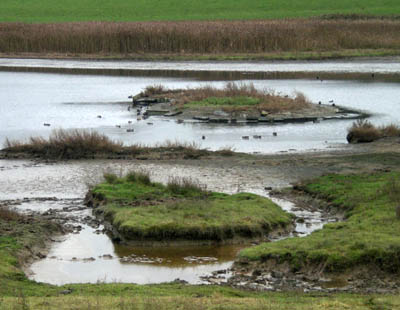
The salt marsh landscape that resulted at Upton Warren has created a unique wildlife reserve but if it isn't managed properly it could quickly disappear. There's a huge problem on the site. In the last few years the amount of salt marsh has been disappearing. Since the 1970s perhaps as much as 90% of the marsh has been lost and soon there could be none left. Deep underground, the water forcing its way through the salt deposits is causing erosion and subsidence so the bottom of the pool is dropping, making the water itself deeper. Rather than a shallow, salty pool, the site is turning into a deep lake.
The University of Worcester has been helping with an aerial survey using a kite, and on the ground volunteers are mapping what the lower water levels reveal using for the first time digital depth gauges and monitors to measure just how salty the pools are. These have been positioned in the water. All of this work will allow the Worcestershire Wildlife Trust who manages the site to map and track exactly how the site behaves. This will hopefully come up with an "ideal" water level for the reserve, with the aim of increasing the amount of salt marsh and the wildlife that thrives on it.
In the picture: one of the three flashes. For more information visit the site where there are trails and hides to observe the wildlife or visit the web site at:

Springs and Salts Elsewhere - Epsom Salts Well
We were recently consulted on a well that had been discovered on the heath near Epsom. The location was in the back garden of a 200 year old cottage located a hundred yards or so away from the original Epsom Medicinal Well. Epsom was famous in the 17th century for its purging Epsom Salts Well and was visited by royalty and the aristocracy. Visitors walked from the town nearby to the well on the common to take the waters and subsequently purge themselves in the bushes nearby. By the early 18th century however a New Wells was operating in the town. Because its location was not on the geological designated Woolwich and Reading Beds, the New Well fell into disrepute having no salt content and Epsom lost its reputation as a leisure centre and spa. The Old Well is now a modern decorative feature in the middle of a housing estate. The question is, does the recently discovered well contain Epsom Salts?
The well was rediscovered as a result of adding an extension to the two centuries old cottage and its location suggests that it may be overlying the Woolwich and Reading Beds. It is about 20 feet deep and murky water could be seen about 5 feet below ground level at the time of inspection. The present well head would not prevent surface and rain water accumulating in the well and so how do we test it for Epsom Salts?
The well was rediscovered as a result of adding an extension to the two centuries old cottage and its location suggests that it may be overlying the Woolwich and Reading Beds. It is about 20 feet deep and murky water could be seen about 5 feet below ground level at the time of inspection. The present well head would not prevent surface and rain water accumulating in the well and so how do we test it for Epsom Salts?
The answer is to pump the well for a couple of days and then let water percolate in from underground, avoiding water from elsewhere. Then boil the resulting well water and see if the residue looks, tastes and acts like Epsom Salts. Could we soon see the local residents once more purging themselves in the bushes nearby? I think not but the test results could be interesting. We will update you when results are known.
In the picture: the resident in the cottage ponders the possibility of becoming the owner of an Epsom Salts source.
Brine Bathing Benefits
Getting older has its advantages. You can be grumpy for no reason and wear whatever you like even though it doesn't match, such as a dress with trainers; or socks with sandals. 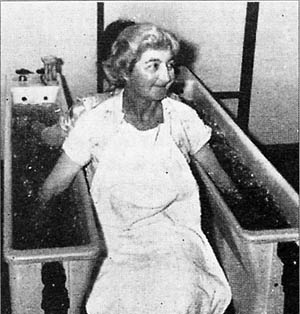 There’s the winter fuel allowance; free bus passes; free eye tests and, if you're seriously old, free television licenses. One disadvantage of ageing is painful joints, particularly hands, hips and knees. From the 1830s to the 1970s, to resolve painful and paralytic effects of rheumatic gout; asthma; sciatica; rheumatism; scrofula; skin diseases; spinal affections or neurology, bathing in Droitwich brine was recommended. This list dates back to 1851and a different terminology is used today for similar conditions. What hasn't changed is the alleged effectiveness of a brine bath. It doesn’t cure rheumatism or arthritis but in perhaps 87% of cases it will alleviate the painful symptoms and improve mobility; permanently in many cases.
There’s the winter fuel allowance; free bus passes; free eye tests and, if you're seriously old, free television licenses. One disadvantage of ageing is painful joints, particularly hands, hips and knees. From the 1830s to the 1970s, to resolve painful and paralytic effects of rheumatic gout; asthma; sciatica; rheumatism; scrofula; skin diseases; spinal affections or neurology, bathing in Droitwich brine was recommended. This list dates back to 1851and a different terminology is used today for similar conditions. What hasn't changed is the alleged effectiveness of a brine bath. It doesn’t cure rheumatism or arthritis but in perhaps 87% of cases it will alleviate the painful symptoms and improve mobility; permanently in many cases.
 There’s the winter fuel allowance; free bus passes; free eye tests and, if you're seriously old, free television licenses. One disadvantage of ageing is painful joints, particularly hands, hips and knees. From the 1830s to the 1970s, to resolve painful and paralytic effects of rheumatic gout; asthma; sciatica; rheumatism; scrofula; skin diseases; spinal affections or neurology, bathing in Droitwich brine was recommended. This list dates back to 1851and a different terminology is used today for similar conditions. What hasn't changed is the alleged effectiveness of a brine bath. It doesn’t cure rheumatism or arthritis but in perhaps 87% of cases it will alleviate the painful symptoms and improve mobility; permanently in many cases.
There’s the winter fuel allowance; free bus passes; free eye tests and, if you're seriously old, free television licenses. One disadvantage of ageing is painful joints, particularly hands, hips and knees. From the 1830s to the 1970s, to resolve painful and paralytic effects of rheumatic gout; asthma; sciatica; rheumatism; scrofula; skin diseases; spinal affections or neurology, bathing in Droitwich brine was recommended. This list dates back to 1851and a different terminology is used today for similar conditions. What hasn't changed is the alleged effectiveness of a brine bath. It doesn’t cure rheumatism or arthritis but in perhaps 87% of cases it will alleviate the painful symptoms and improve mobility; permanently in many cases.The UK is one of the few areas in Europe where spa treatment is little recognised as being beneficial in retaining and regaining health. Here, we resort to pills, injections and surgery, each of which can have unkind side effects. Spa treatments, including brine bathing, have no unpleasant side effects.
Pictures courtesy Droitwich Spa Heritage Centre - an arm bath and below a reclining bath.
Traditional methodology for alleviating painful joints
Hands, fingers and feet: REMOVE ALL JEWELLERY FROM HANDS and find a good programme on the television. Take a receptacle that the painful joint will fit into - a cup or pudding basin for hands; a washing-up bowl for feet. Add enough pleasantly hot water to cover the limb and dissolve into it common salt (sodium chloride, although Epsom Salts works just as well) - approx.. half a pound (250g) per gallon. Bathe limb for 45 minutes. Repeat this after two days and again after three days; don't expect an immediate reaction. If there is no improvement three days after this, you're one of the unlucky 13%. REMEMBER - pills, injections and surgery are not 100% effective either. Cups and bowls can be covered with cling film and the water reused as many times as you like.
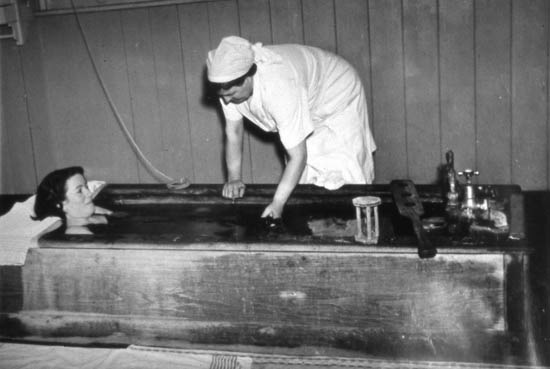
Hips and knees: Take an alarm clock, good book, towel, cloth for wiping moisture from spectacles. Add hot water to bath sufficient to cover joint and dissolve salt into it. One pound may be enough but more won't do any harm. Sit in bath. When the water gets cool, add more hot water and a couple of handful of salt. Get out after 20 minutes and rest in a warm bed for 5-10 minutes. Repeat after two days and again after three days. That should be enough to make a difference.
Please note that if you decide to try the above it is at your own risk. If it works send your method, pictures and results to us and we'll feature them in the Friends' newsletter so that others can benefit.
Email: springs@thespas.co.uk (click here to send an email)
Website: Click Here
SUPPLEMENTARY INFORMATION
The home page can be accessed by clicking website above.
Contact Information:
Friends main website - www.MalvernWaters.com
 Newsletter Archive which can also be accessed from our WEB SITE INDEX.
Newsletter Archive which can also be accessed from our WEB SITE INDEX.
Friendship - There is no charge made for joining Friends of Malvern Springs and Wells. Just let us have your email address and we will send our newsletters, which are usually two monthly. Please be aware that some email addresses block large circulation emails. Do feel free to participate in our activities by contacting us below.
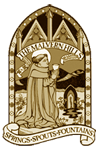
Best wishes, Cora & Bruce
Bruce Osborne, Tower House, Tadworth, Surrey. KT20 5QY
Tel. 01737 213169 email bruce@thespas.co.uk
Tel. 01737 213169 email bruce@thespas.co.uk
Cora Weaver, 4 Hall Green, Malvern, Worcs. WR14 3QX
Tel. 01684 561215 email cora@malvernspa.com
Tel. 01684 561215 email cora@malvernspa.com
1) TOPOGRAPHICAL LOCATION:
Malvern Hills - arguably Britain's original National Park
3) INFORMATION CATEGORY:
Springs and Wells General InterestHistory & Heritage
Friends Newsletter



